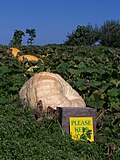
Gourds include the fruits of some flowering plant species in the family Cucurbitaceae, particularly Cucurbita and Lagenaria. The term refers to a number of species and subspecies, many with hard shells, and some without. One of the earliest domesticated types of plants, subspecies of the bottle gourd, Lagenaria siceraria, have been discovered in archaeological sites dating from as early as 13,000 BCE. Gourds have had numerous uses throughout history, including as tools, musical instruments, objects of art, film, and food.

Cucurbita is a genus of herbaceous fruits in the gourd family, Cucurbitaceae, native to the Andes and Mesoamerica. Five edible species are grown and consumed for their flesh and seeds. They are variously known as squash, pumpkin, or gourd, depending on species, variety, and local parlance. Other kinds of gourd, also called bottle-gourds, are native to Africa and belong to the genus Lagenaria, which is in the same family and subfamily as Cucurbita, but in a different tribe. These other gourds are used as utensils or vessels, and their young fruits are eaten much like those of the Cucurbita species.

Spaghetti squash or vegetable spaghetti is a group of cultivars of Cucurbita pepo subsp. pepo. They are available in a variety of shapes, sizes, and colours, including ivory, yellow and orange, with orange having the highest amount of carotene. Its center contains many large seeds. When raw, the flesh is solid and similar to other raw squash. When cooked, the meat of the fruit falls away from the flesh in ribbons or strands that look like and can be used as an alternative to spaghetti.

Cucurbita pepo is a cultivated plant of the genus Cucurbita. It yields varieties of winter squash and pumpkin, but the most widespread varieties belong to the subspecies Cucurbita pepo subsp. pepo, called summer squash.

The zucchini, courgette or baby marrow is a summer squash, a vining herbaceous plant whose fruit are harvested when their immature seeds and epicarp (rind) are still soft and edible. It is closely related, but not identical, to the marrow; its fruit may be called marrow when mature.

Calabaza is the generic name in the Spanish language for any type of winter squash. Within an English-language context it specifically refers to the West Indian pumpkin, a winter squash typically grown in the West Indies, tropical America, and the Philippines. Calabaza is the common name for Cucurbita moschata in Cuba, Florida, Puerto Rico, and the Philippines. C. moschata is also known as auyama in Colombia, the Dominican Republic and Venezuela; ayote in Mexico and Central America; zapallo in certain countries of South America; and "pumpkin", "squash", or "calabash" in English-speaking islands.
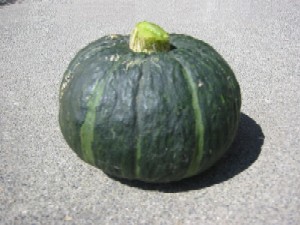
Kabocha is a type of winter squash, a Japanese variety of the species Cucurbita maxima. It is also called kabocha squash or Japanese pumpkin in North America. In Japan, "kabocha" may refer to either this squash, to the Western pumpkin, or indeed to other squashes. In Australia, "Japanese pumpkin" is a synonym of Kent pumpkin, a variety of winter squash.

A pumpkin seed, also known in North America as a pepita, is the edible seed of a pumpkin or certain other cultivars of squash. The seeds are typically flat and oval with one axis of symmetry, have a white outer husk, and are light green in color after the husk is removed. Some pumpkin cultivars are huskless, and are grown only for their edible seed. The seeds are nutrient- and calorie-rich, with an especially high content of fat, protein, dietary fiber, and numerous micronutrients. Pumpkin seed can refer either to the hulled kernel or unhulled whole seed, and most commonly refers to the roasted end product used as a snack.

Cucurbita ficifolia is a species of squash, grown for its edible seeds, fruit, and greens. It has common names including Asian pumpkin, black seed squash, chilacayote, cidra, fig-leaf gourd, and Malabar gourd. Compared to other domesticated species in its genus, investigators have noted that samples of C. ficifolia from throughout its range are relatively similar to one other in morphology and genetic composition. Variations do occur in fruit and seed color, some isozymes, and photoperiod sensitivity.

The Eastern Agricultural Complex in the woodlands of eastern North America was one of about 10 independent centers of plant domestication in the pre-historic world. Incipient agriculture dates back to about 5300 BCE. By about 1800 BCE the Native Americans of the woodlands were cultivating several species of food plants, thus beginning a transition from a hunter-gatherer economy to agriculture. After 200 BCE when maize from Mexico was introduced to the Eastern Woodlands, the Native Americans of the eastern United States and adjacent Canada slowly changed from growing local indigenous plants to a maize-based agricultural economy. The cultivation of local indigenous plants other than squash and sunflower declined and was eventually abandoned. The formerly domesticated plants returned to their wild forms.

Cucurbita moschata is a species originating in either Central America or northern South America. It includes cultivars known as squash or pumpkin. C. moschata cultivars are generally more tolerant of hot, humid weather than cultivars of C. maxima or C. pepo. They also generally display a greater resistance to disease and insects, especially to the squash vine borer. Commercially made pumpkin pie mix is most often made from varieties of C. moschata. The ancestral species of the genus Cucurbita were present in the Americas before the arrival of humans. No species within the genus is fully genetically isolated from all the other species. C. moschata can be hybridized with all other species. It has been suggested that this shows that the species of Cucurbita have diversified more recently than those of related genera such as Cucumis and Citrullus.

The name squash bee, also squash and gourd bee, is applied to two related genera of bees in the tribe Eucerini; Peponapis and Xenoglossa. Both genera are oligoleges on the plant genus Cucurbita and closely related plants, although they usually do not visit watermelon, cucumber, and melon plants. They are small genera, containing only 13 and 7 described species, respectively, and their combined range is nearly identical to the range of Cucurbita in the New World, from South America to North America. Their range has become somewhat expanded along with the movement of cucurbits into other areas.
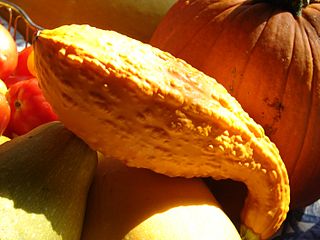
Crookneck squash, also known as yellow squash, is a cultivar of Cucurbita pepo, the species that also includes some pumpkins and most other summer squashes. The plants are bushy and do not spread like the plants of winter squash and pumpkin. Most often used as a summer squash, it is characterized by its yellow skin and sweet yellow flesh, as well as its distinctive curved stem-end or "crooked neck". It should not be confused with crookneck cultivars of Cucurbita moschata, such as the winter squash 'Golden Cushaw', or the vining summer squash 'Tromboncino'. Its name distinguishes it from another similar-looking variety of C. pepo, the straightneck squash, which is also usually yellow. There is one similar non-edible C. pepo variety: C. pepo var. ovifera.
Summer squash are squashes that are harvested when immature, while the rind is still tender and edible. Nearly all summer squashes are varieties of Cucurbita pepo, although not all Cucurbita pepo are considered summer squashes. Most summer squash have a bushy growth habit, unlike the rambling vines of many winter squashes. The name "summer squash" refers to the short storage life of these squashes, unlike that of winter squashes.

Delicata squash is a variety of winter squash with cylindrical fruits that are cream-coloured and striped in green or orange. As its name suggests, it has characteristically a delicate rind. It is also known as peanut squash, Bohemian squash, or sweet potato squash. It is a very sweet variety with a thin, edible skin and is typically cut into half rounds and roasted. It is a cultivar of the species Cucurbita pepo, which also includes the summer squash varieties pattypan squash, zucchini, and yellow crookneck squash, as well as winter squash varieties including acorn squash, spaghetti squash, and most pumpkins used as Jack-o-lanterns.

Winter squash is an annual fruit representing several squash species within the genus Cucurbita. Late-growing, less symmetrical, odd-shaped, rough or warty varieties, small to medium in size, but with long-keeping qualities and hard rinds, are usually called winter squash. They differ from summer squash in that they are harvested and eaten in the mature stage when their seeds within have matured fully and their skin has hardened into a tough rind. At this stage, most varieties of this vegetable can be stored for use during the winter. Winter squash is generally cooked before being eaten, and the skin or rind is not usually eaten as it is with summer squash.
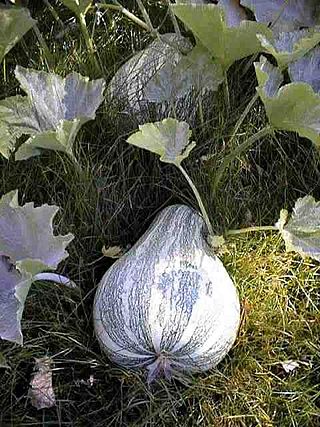
Cucurbita argyrosperma, also called the cushaw squash and silver-seed gourd, is a species of winter squash originally from the south of Mexico. This annual herbaceous plant is cultivated in the Americas for its nutritional value: its flowers, shoots, and fruits are all harvested, but it is cultivated most of all for its seeds, which are used for sauces. It was formerly known as Cucurbita mixta.

Peponapis pruinosa is a species of solitary bee in the tribe Eucerini, the long-horned bees. Its common name is the eastern cucurbit bee. It may be called the squash bee, but this name can also apply to other species in its genus, as well as the other squash bee genus, Xenoglossa. This bee occurs in North America from the East Coast of the United States to the West Coast and into Mexico. It is an oligolege, specializing on a few host plants, the squashes and gourds of genus Cucurbita. Its range expanded as human agriculture spread throughout North America and squash plants became more abundant and widespread. It may also have spread naturally as the range of its favored wild host plant Cucurbita foetidissima expanded.

Cucurbita ecuadorensis is a species of squash, described in 1965 as growing wild in Ecuador. Like most wild gourds and squashes, it is a creeping vine and is often found climbing over other vegetation. It has been found only in the western provinces of Guayas and Manabí. There is evidence that it was domesticated in Ecuador around 10,000 years ago, likely for its seeds, but no direct records exist and it is no longer cultivated. It is resistant to many diseases of cultivated Cucurbita species, and has been used to breed resistance to several diseases into common squashes. For example, researchers at Cornell University used Cucurbita ecuadorensis to breed resistance to papaya ringspot virus, watermelon mosaic virus, and powdery mildew, into common Cucurbita maxima cultivars. Cucurbita ecuadorensis is listed on the IUCN Red List as vulnerable, and is found protected in the Machalilla National Park.
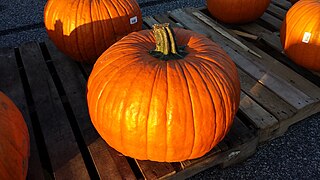
Connecticut field pumpkins are a type of pumpkin first attested in the 16th century. They are one of the oldest varieties of pumpkin in existence and are known as an heirloom plant. One of the most popular Halloween pumpkins, Connecticut field pumpkins are commonly used for autumn decorations and jack-o'-lanterns; a strain of Connecticut field pumpkins have been described as "the original commercial jack-o'-lantern pumpkin". Due to the variety's appearance and growth process, it is considered to be well-suited for ornamental use. It also has culinary uses, particularly in canning, and was used for medicinal purposes by Native Americans in the United States prior to European contact.















